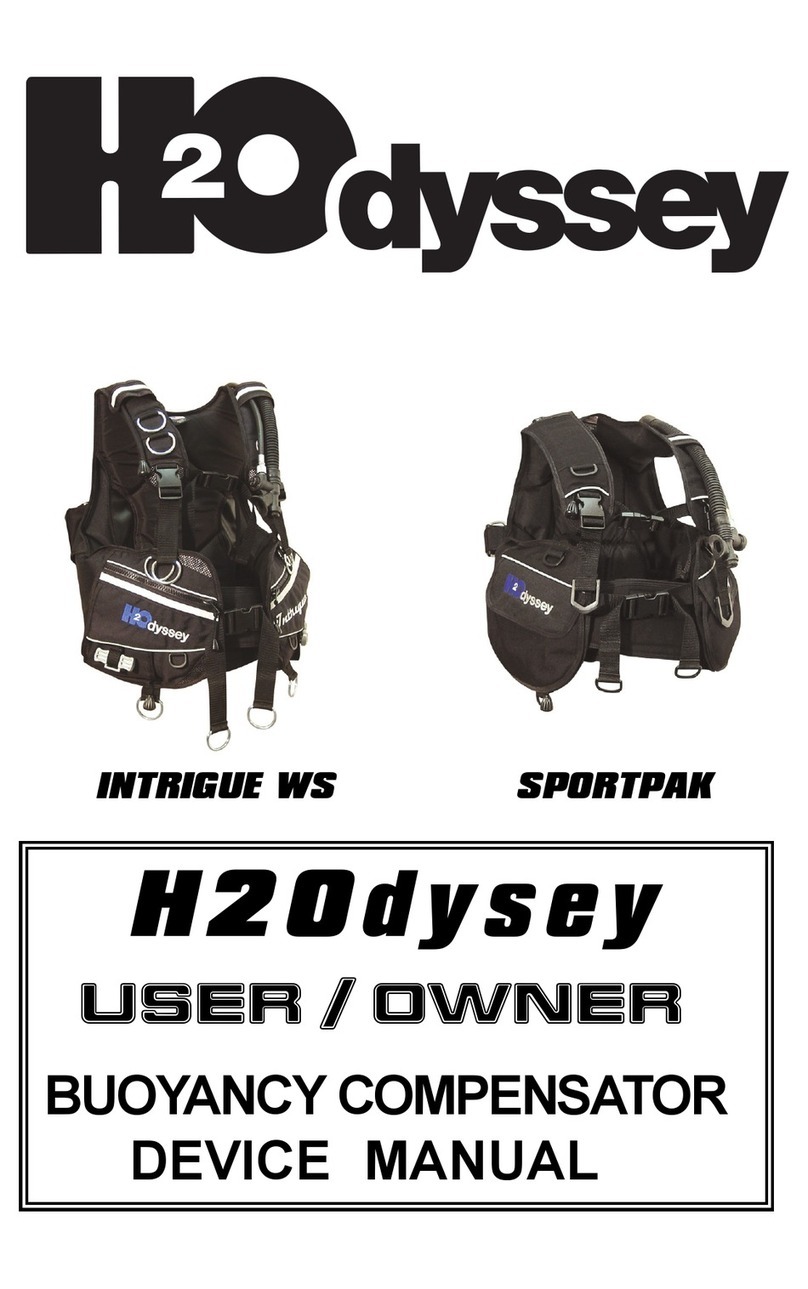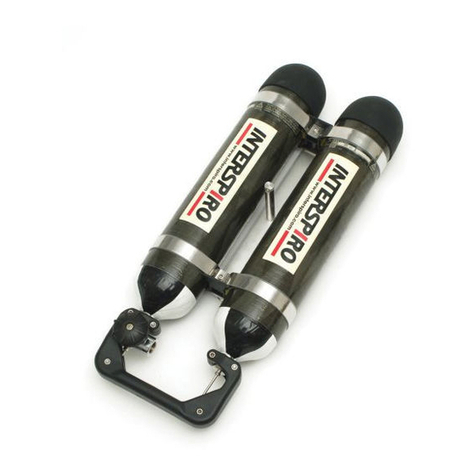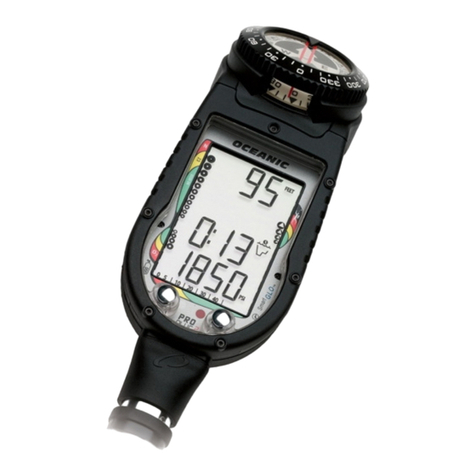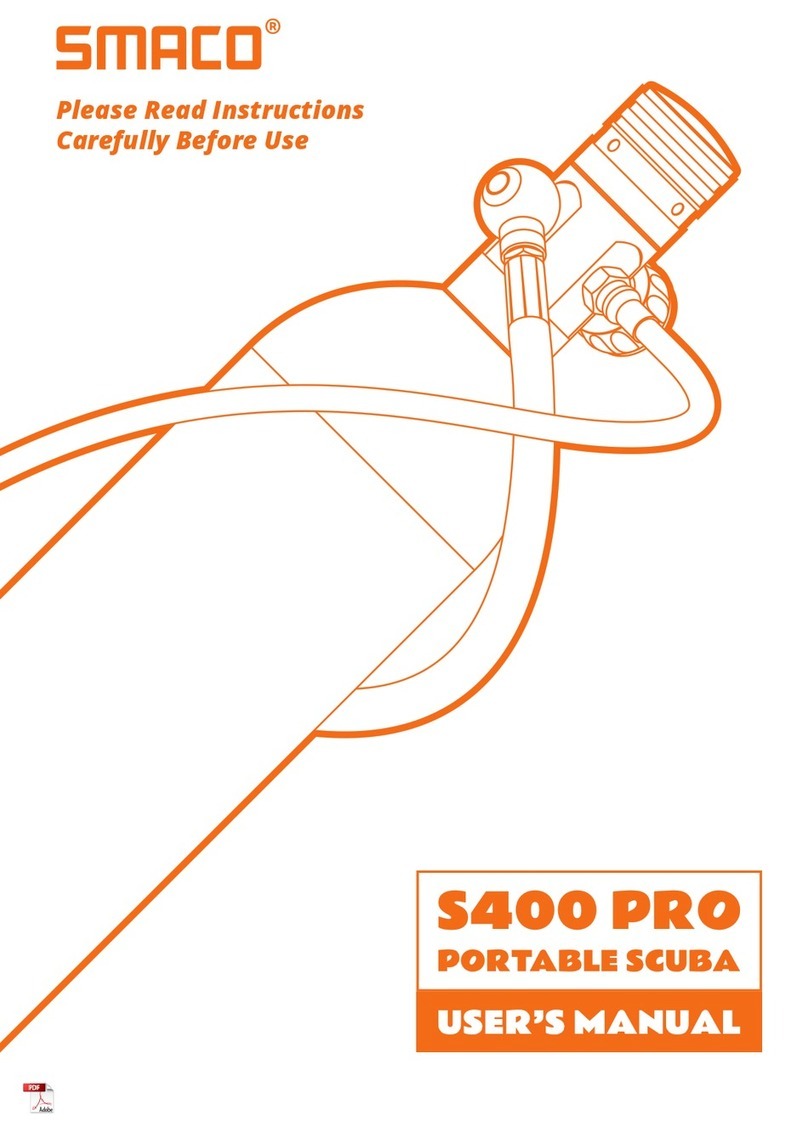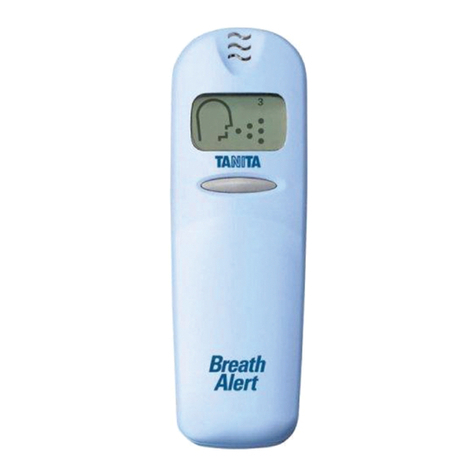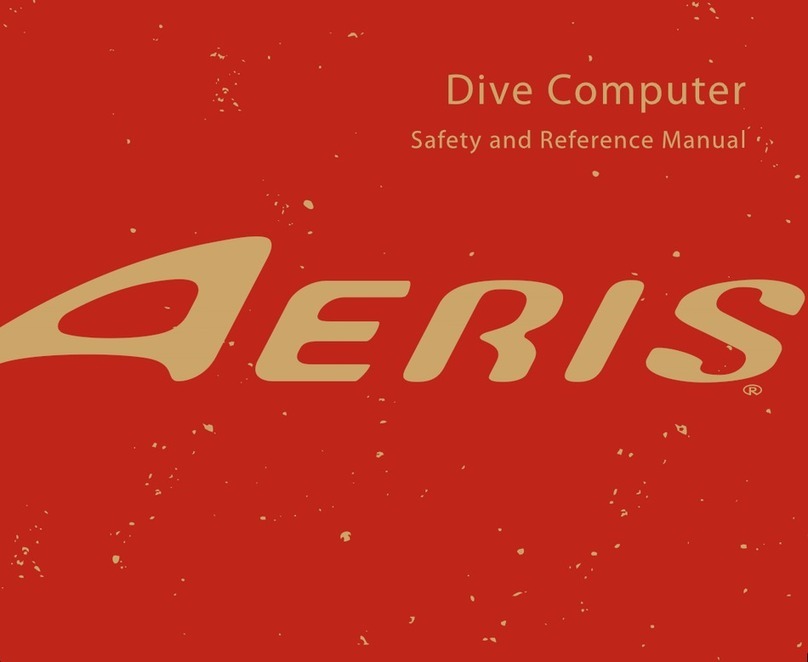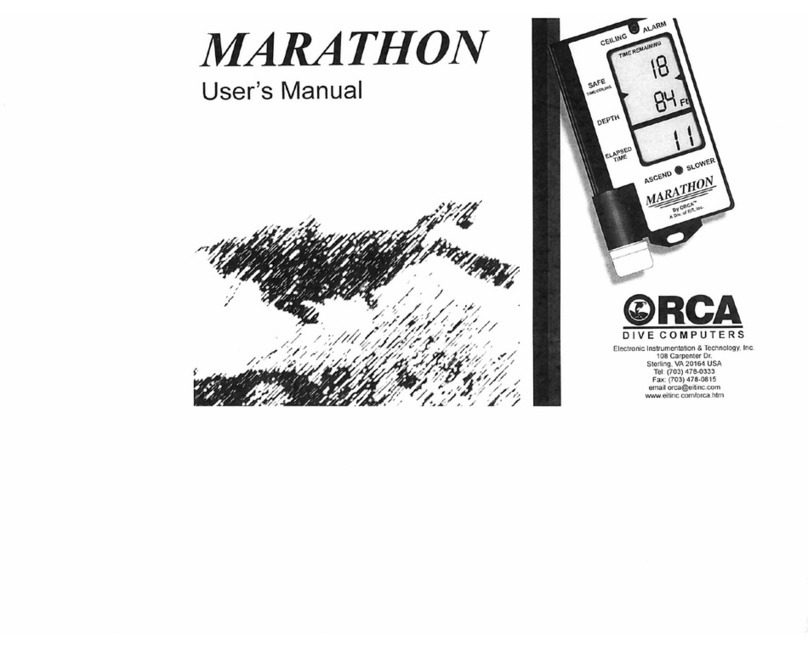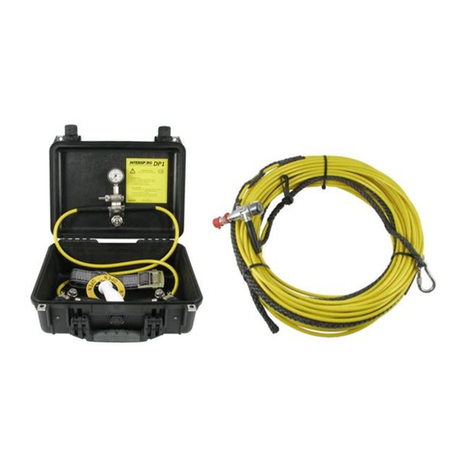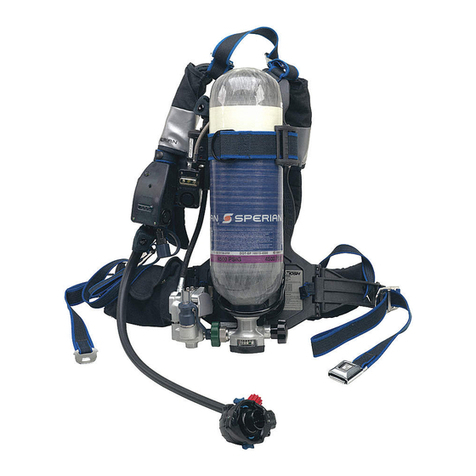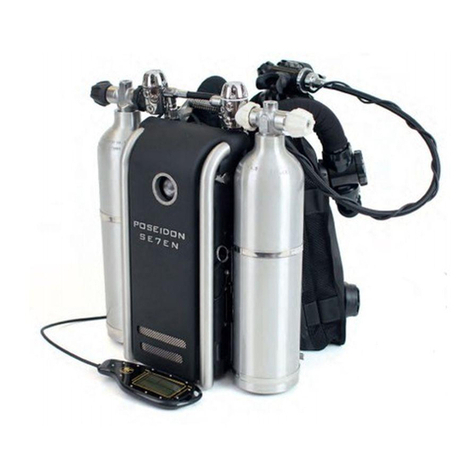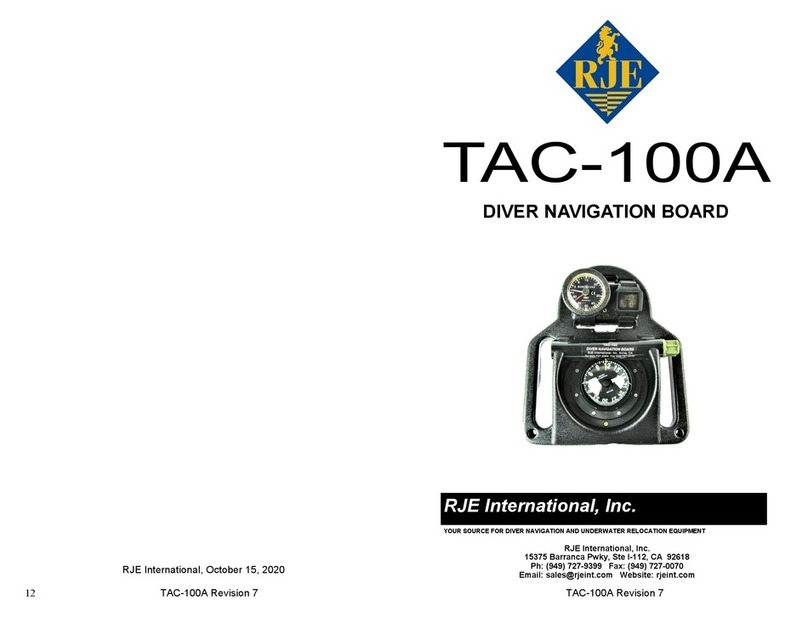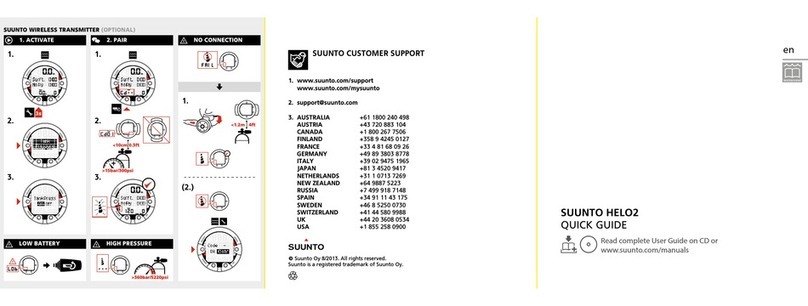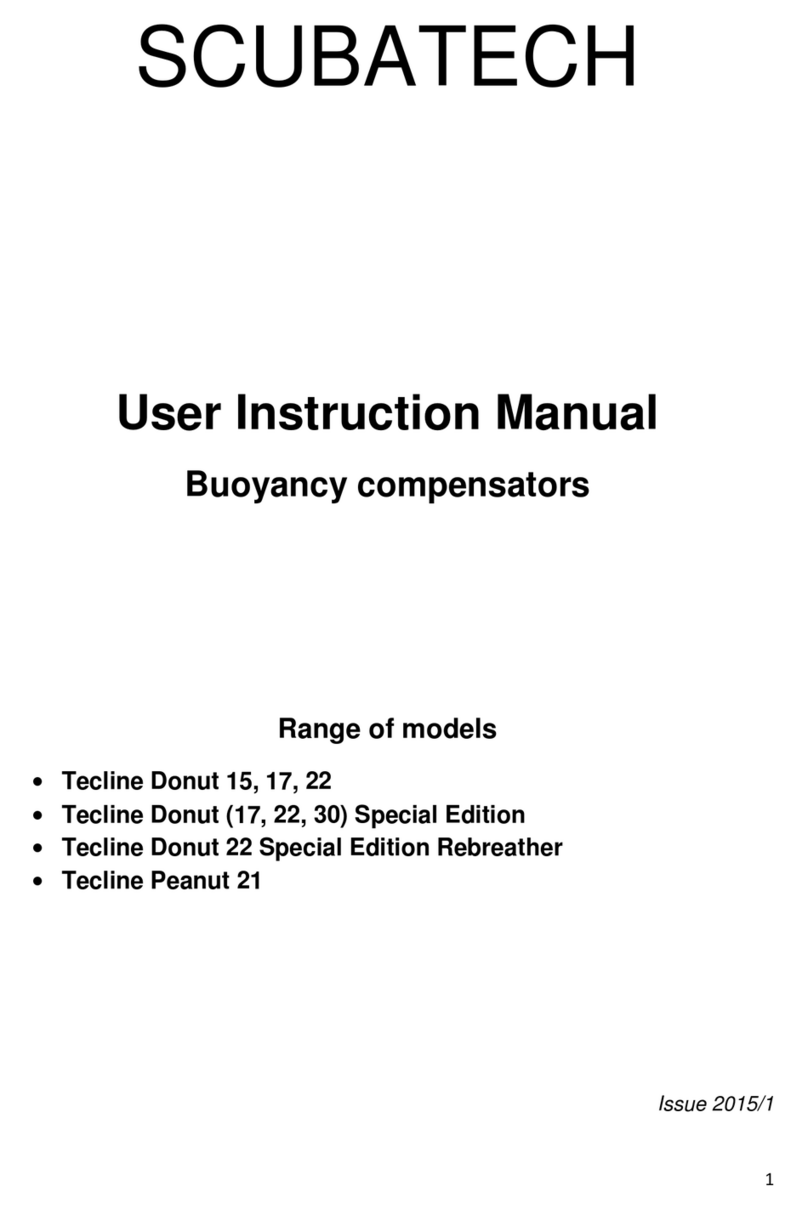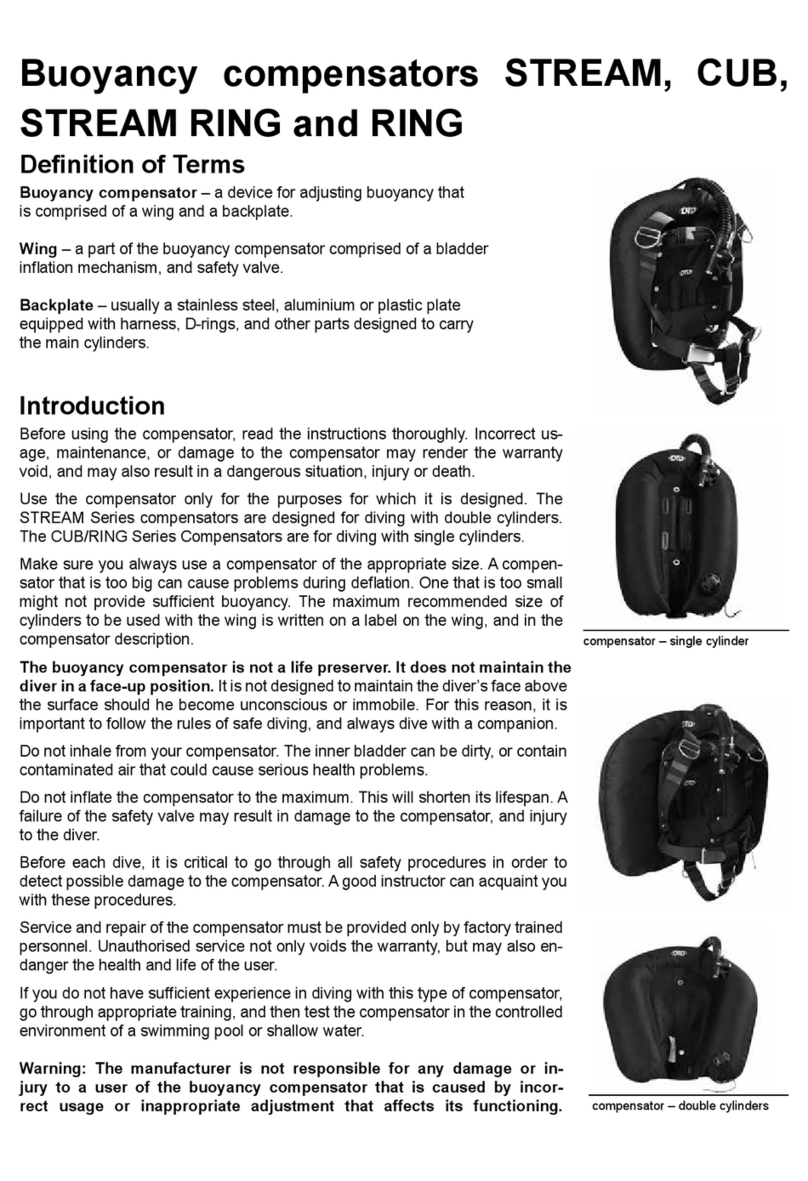Seagow 200 Operator's manual

This user manual is protected by a copyright. All rights reserved. Do not copy, duplicate,
record, translate or spread the document without the written agreement of Seagow. Seagow
is a trademark.
V. 1.2 from 11th November 2018 (check the updated version on www.seagow.com)
User manual
&
Safety instructions
!
Seagow 200
&
Seagow 300

Preamble
Thanks for choosing Seagow. You are now free to breath under water with an
equipment made and designed with the collaboration of beginners and
experienced underwater divers.
To begin with, before the first use of a Seagow product, it is very important to
entirely read and understand this instruction manual.
Please, always be sure that the product is used according to the conditions
defined in this manual, no matter who the user is.
Seagow can not be held as responsible of any material or physical accident in
case of non respect of the given instructions.
Seagow was developed to be used in sea or swimming pools. A use in a
different environment can potentially accelerate the aging of the equipment.
Seagow retains the right to change or to improve the manual without warning.
Please get to know the current version during the usage of the product.
It is necessary to keep the user manual during the life of the product. You can
also find it on the updated version website www.seagow.com.
The end of particular parties contains the mention "WARNINGS" to underline a
specific situation which have to be taken into consideration to avoid a risky
situation.
To be put in a plane for a journey, the tank must not be pressurized, you will
certainly need to unscrew the cylinder tank from the valve. To do this, drag the
protection of the tank towards the valve and unscrew (counterclockwise)
simply the 2 elements. These 2 elements must be screwed down properly with
the original O-ring for reassembly.
INSTRUCTIONS TO RESPECT IMPERATIVELY
Open COMPLETELY the valve before use
NEVER block your breathing, breathe continuously
NEVER go up to the surface faster than air bubbles
Use at SHALLOW depth
Watch your MANOMETER VERY REGULARLY
USE PROHIBITED WITHOUT KNOWLEDGE OF USE HAZARDS

Table of contents
1. Content of the box
2. Warnings
3. Description
4. Technical features
5. Precautions of general use
5.1 Before diving
5.2 During diving
5.3 After diving
6. Refill of compressed air
6.1 Filling with the Seagow compressor
6.2 Filling with a classic dive compressor
7. Dangers
8. Storage
9. Maintenance
10. Warranty
11. Norms and regulation
12. Behaviors to follow and avoid during diving

1. Content of the box (not including pack and
options)
•1x 0,5 L Aluminium diving tank with his DIN valve
•1x First stage regulator
•1x Manometer
•1x Medium Pressure hose
•1x Second stage regulator
•1x Manual & safety instructions
•1x White fastening system (belt)
•1x Black necklace
2. Warnings
•We advice users to follow the elementary rules related to the scuba
diving which are given by authorized organizations
•A use without the awareness of the security rules endangers the user
•Don't use Seagow with an air supply from the surface
•No assembly of setting can be done by the user, except the ones provided
by this purpose
•A piece or an element of the Seagow should not be used on an other
device, or else the guarantee could be cancelled and the users could
endangers themselves
•Always open slowly and completely the valve and orient the
manometer (gauge) towards the ground
•The recommended minimum age to use the Seagow is eight (under adult
supervision)
•Never grease the pieces of the equipment, it can lead to the deterioration
of the equipment and of the leakproof seals
•The user always has to correctly ready the good pressure unit (bar or
PSI) on the manometer(s)
WARNINGS
•The use of Seagow under 3 m (10 ft) depth is forbidden for any person
who did not follow specific formation of scuba diving from an official center

3. Description
4. Technical features
Seagow 200 :
-Internal water volume of the tank : 0,5 L
-Maximum authorized pressure (PS) : 200 bar (3000 PSI)
-Service temperature : +10°C / +40°C (50°F / 104°F)
-Weight : 2,2 kg (4,8 lbs) empty
-Dimensions (L x d) : 24,5 x 11 cm
-Maximum authorized depth of use : 3 m (10 ft)
-Maximum operational depth of the equipment (allowed for certified
divers according to their scuba certification) : 50 m (164 ft)
Seagow 300 :
-Internal water volume of the tank : 0,5 L
-Maximum authorized pressure (PS) : 300 bar (4500 PSI)
-Service temperature : +10°C / +40°C (50°F / 104°F)
-Weight : 2,5 kg (5,5 lbs) empty
-Dimensions (L x d) : 33 x 11 cm
-Maximum authorized depth of use : 3 m (10 ft)
-Maximum operational depth of the equipment (allowed for certified
divers according to their scuba certification) : 50 m (164 ft)
Valve
Manometer
(gauge)
2nd stage!
regulator
Tank
1st stage!
regulator

5. Precaution of general use
•Due to its vital fonction, always use it with care
•Never force on the valve
•When Seagow is not used, don't let the top compartment (regulators
and flexible) under pressure, purge the air thanks to the second stage
membrane
•Too much stress on the second stage membrane can engender a too
important air expulsion, to stop it, obstruct the mouthpiece
•Avoid any contact between sand or condiment and the Seagow
•Don't expose the material to the sun for a long time
•During the first use, connect the first stage regulator to the valve and make
a complete test of the tank into the air to evaluate your feeling
•Be careful when you unscrew the first stage regulator (especially if it’s not
completely purged) because it can expel the Oring between the valve
and 1st stage regulator, put it again in the groove provided for this
purpose if this is the case
•Only screw and unscrew the 1st stage by the plastic washer
WARNINGS
•In case of leak or suspicion of dysfunction, do not place your ears near the
equipment, close the valve and refer to these instructions, contact your
dealer if necessary
5.1 Before diving
•In addition to a good health, it is necessary for the user to consult an
health specialist
•Visually control the equipment before opening the valve
•Before connecting the first stage to the valve, tie the black scratch tape to
the valve.
•The MP and HP outputs of the first stage should not be easily slacked by
hands when the pressure regulator is not under pressure, idem for hose /
2nd stage regulator connexion
•As a precaution, during the opening of the valve, do not direct the
manometer towards you
•To open the tank, slowly turn the handle of the valve in the
counterclockwise direction, valve must be completely open, then make
a quarter turn backwards (do not let the valve reach the stop)

•Tie the black scratch tape to your neck and tie the white one to the tank
and to your waist.
•Make 2 or 3 inspiration/expiration cycles test before setting to water
to check the proper functioning
•Never do a rotation (except the ones provided by this purpose) of the
element after the pressurization
•Adapt your dive to the pressure on the manometer
WARNINGS
•If the valve is not completely opened, the user will not be able to use all
the compressed air of the tank. That’s why it is essential to entirely open
the valve and then to do a quarter turn backwards
5.2 When diving
•Always adopt flexible and continuous breathing to optimize your
autonomy under water
•Use the equipment in a water above +10°C (50°F)
•Seagow should only be used by one person at a time
•The maximum depth authorized is 3 m (10 ft)
•Regularly control the remaining pressure of the tank with the
manometer
•The user should stay at the surface when the remaining pressure is
equal or inferior to 50 bar (725 PSI) (red zone of the manometer)
•Stop the dive in case of leak coming from the Seagow, slowly go back up
to the surface
•Plan to stop using the equipment before the total lack of compressed air
WARNINGS
•Never go back up to the surface faster than the air bubbles
•Stop the dive in case of discomfort towards the ears or sinuses, do
not dive with a cold
•NEVER stop your breathing during your descent or your ascent
•Do not immerge the Seagow 200 or 300 when it is not pressurized

5.3 After diving
After using the Seagow please follow the following instructions :
-Remove the remaining water in the second stage
-Untie the white scratch tape from your waist
-Carry the tank and untie the black scratch tape from your neck (be
careful not to drop the tank)
-Close the valve
-Purge the remaining air by pressing the second stage regulator
membrane
-Rince the equipment with pure water
-Unscrew the first stage regulator from the valve
-Let the equipment dry
•Do not use aerosols or other solvents for the cleaning
WARNINGS
•The cleaning of the second stage has to be done gently. A too strong
water jet through the mouthpiece can damage the internal membrane
6. Refill of compressed air
•The person who refills the tank is responsible for the quality of the
compressed air
•If there is a difference between the pressure of the compressor and the
manometer of the tank which has to be refilled, take into consideration
the higher value.
WARNINGS
•The seacow 200 should not be refilled with a pressure superior to
200 bar (3000 psi). It is to the person responsible of the refilling to
make sure of this.
•The seacow 300 should not be refilled with a pressure superior to
300 bar (4500 psi). It is to the person responsible of the refilling to
make sure of this.

6.1 Filling with the Seagow compressor
For this part, please refer to the Seagow Compressor user manual, supplied
with the latter
6.2 Filling with a classic dive compressor
•The handling of a classic dive compressor must be performed by a
qualified person
•When the first stage is separated from the valve, protect it thanks to the
supplied protection
•During the reassembling of the first stage regulator, make sure that the
outputs are well-oriented
WARNINGS
•This handling of a classic dive compressor has to be done by a
qualified person
•The outlet air flow rate of the compressor has to be slowed down
compared to the filling of a scuba tank called « usual » of several
litters
•The filling must be done very slowly, from 0 to 200 bar (3000 PSI) in 2
mins 30 secs minimum
•The filling must be done very slowly, from 0 to 300 bar (4500 PSI) in 3
mins minimum
•Make a break during the filling in case of a too important heating and
let the tank cool
7. Dangers
•The non-respect of these elementary rules of scuba diving may engender
risks of drowning or physical damages which can cause death
•In case of shock, the equipment can be damaged without visual harms, in
case of doubt, make your equipment inspected by a specialist
•It is totally forbidden to change the layout or to modify the different parts of
the Seagow
•Never integrate elements from the Seagow on an other (diving) equipment
or vice versa
•Never introduce water in the equipment

8. Storage
•After the drying, store the products in a box or a clean and closed bag
•Store the products in a dry place, protected from the light, between +5°C
and 35°C (41°F to 35 °F)
•Let the valve closed during storage, the top compartment should not be
under pressure
•Do not store the products near gasolines, oils or other chemical products
•Do not store the products in a dusty place or where there is sand
•The flexible should be free from all constraints, tank should be in a vertical
position, valve to the top
•During storage, remove the first stage regulator from valve and
protect the output with the cap included
9. Maintenance and upkeep
•The proper functioning and the proper preservation of your equipment do
not necessarily depend on its use frequency. Even when it is not used, a
bad storage can significantly damage the device
•Make your Seagow regularly inspected by a specialist, an annual
inspection is recommended
•The French law doesn’t impose inspection for the Seagow 200, bu the
inspection is mandatory for the Seagow 300. Even if it is not mandatory,
we but recommended inspection for the Seagow 200 (inquire by
country)
•The French law do not impose inspection or obligatory re-test for the
pressure regulator but it is advisable (inquire by country)
•Prefer the replacement of a defective piece by an original one
•If there is a leak in the 1st stage, tighten the MP output with your hand and
the DIN connection with an Allen key
•Do not try to fix your equipment by yourself else-way than by the
instructions given in this manual
•Do not forget that your security and the proper functioning of your
equipment depend on its maintenance
•For the upkeep of your regulators and your tank, consult a diving center
10. Warranty
•The equipment is guaranteed for one year starting from the date of
purchase of the products

•The guarantee is only valid for the first owner of the equipment
•In case of claim for guarantee, you will have to have a proof of purchase
delivered by your dealer
•This guarantee is only valid for « defective » parts due to a manufacturing
fault
•A non-followed maintenance can engender a guarantee cancellation
•The guarantee does not cover the damages caused by a faulty use or by
carelessness like it is said in this present document
•The guarantee does not take in charge the « normal » usury of the
products. The guarantee does not include the recommended periodic
inspections. The guarantee is invalidated if the equipment has been
disassembled in a different way from this guide
•In a case of modification of the product by a qualified person, he or she
undertakes the responsibility of the repairs/changements done on the
product
•The guarantee is available for the repair or the replacement of a part by
Seagow, the freight charges and the packing costs are on the buyer
•The exchanged pieces are Seagow's goods. These new replaced pieces
cannot extend the guarantee of the product in any case
•The responsibility resulting from the sale is limited to the described
guarantee above. It excludes the possibility to use penalties, damages and
interests
•The rules is apt to change according to the territories at a later writing date
of the manual, an adaptation can be necessary
•Every modification of the product involves the loss of the guarantee and
can involve risks during the use
•Do not interchange the parts between other equipments or your guarantee
can be cancelled
•To benefit from the guarantee, please contact your dealer
11. Standards and regulation
•The regulators meet to standard EN250
•The products are evaluated, controlled and certified CE (n°0062), under
the 2014/68.UE directive, the UE declaration of conformity is available on
simple request
•Other norms or rules may be applied for some areas, including some in
the European Union

12. Behaviors to follow and avoid during diving
The non-respect of these instructions can expose you to dangers
leading to serious consequences on your health.
Preamble
The scuba diving is a risky activity if it’s done without knowledge of safety
rules. You will find in this document the main tips to follow and avoid to make
your dives enjoyable leisure time. Other tips may be given by qualified diving
instructors.
Rules & basics advises
Prior to diving, it is highly advisable to consult your doctor to assess
your fitness to dive.
If you suffer from cardiovascular disease, asthma, diabetes, heart disease or
vascular, ENT diseases, epilepsy and other neurological disorders, scuba
diving practice is strongly discouraged. It also applies to transient diseases
such as colds, sinusitis, bronchitis, infection of the nose, throat, ears (otitis)
or teeth (caries).
Other factors must also make you give up scuba diving as peptic ulcer
disease, retinal detachment, glaucoma, enlarged spleen (splenomegaly) or
pregnancy.
You will find in Annex a (french) document of the FFESSM (French CMAS)
with a more complete list of contra-indications.
Do not fly and avoid ride in altitude the same day of diving.
Throughout the dive, you need to adopt a continuous breathing while
regularly checking your manometer gauge.
Do not use earplug, they prevent pressure equalization. Dive only if you feel
good and you feel like it, hydrate yourself before and after the dive (to avoid
drying up the mucous membranes with the cool and dry air)
The descent
The descent (even shallow) leads to an increase of the ambient pressure. To
maintain a level of equal pressure between you and the environment, you
have to do the maneuver of Valsalva. This process involves blowing (slowly)
while holding your nose pinched and your mouth shut. By performing this
operation you avoid the main risk during the descent : barotrauma, which
exerts its effects on the eardrums and sinuses mainly.

If you can’t do this procedure correctly, you shouldn’t go deeper,
ascend slowly to the surface.
The ascent
During the ascent, you have to do the maneuver of Toynbee, simply pinch
your nose but this time swallowing (swallowing saliva).
Pulmonary overpressure accident is one of the most serious dive
accident, it occurs when the diver stops breathing during an ascent. To
avoid this, simply adopt a flexible and continuous breathing.
The diver's ascent speed mustn’t be faster than the small air bubbles.
For experienced users and graduates of an accredited center, the ascent of
a significant depth may require decompression according to the dive time
and the depth reached. The goal is to remove nitrogen accumulated in your
body, if you ascend too quickly, the nitrogen will not be eliminated. Worse,
gas bubbles of blood-borne risks to block some vessels, it can cause among
other risk paralysis or thrombosis.
Any pain or discomfort during ascent or descent should get you to stop your
progress. Go slowly and gradually to the surface while controlling the
pressure of your tank and your breathing.
Physical effort
Do not make useless efforts before and especially during and after the dive.
Do not apnea before and after the dive.
Never attempt to exceed your limits, the Seagow 200 or 300 isn’t developed
for performance.
Manage your breath, in case of shortness of breath, slowly and gradually
head towards the surface by adopting the slower breathing you can.
Adaptation to the environment
Underwater, touch only the elements you know and safely.
Adapt your dive to your environment, poor visibility can be a stressful factor.
Stress is often the beginning of a vicious circle ending accident, stress
management is essential assure a good dive.
Equip yourself the dive environment, choose a suitable mask and flippers.
An emergency snorkel is also advisable.
Cold can also be a stress factor, a suitable combination reduces problems
due to cold as breathlessness.
Do not dive in too choppy water, assess the current and ask about the
weather

Annex
F.F.E.S.S.M. C.M.P.N. Édition du 4 janvier 2012
CONTRE-INDICATIONS à la PLONGEE en SCAPHANDRE AUTONOME
Cette liste est indicative et non limitative. Les problèmes doivent être abordés au cas par cas, éventuellement avec un bilan auprès d'un spécialiste, la décision tenant
compte du niveau technique (débutant, plongeur confirmé ou encadrant).
En cas de litige, la décision finale doit être soumise à la Commission Médicale et de Prévention Régionale,
puis en appel, à la Commission Médicale et de Prévention Nationale.
Contre indications définitives
Contr
e indications temporaires
Cardiologie
Cardiopathie congénitale
Insuffisance cardiaque symptomatique
Cardiomyopathie obstructive
Pathologie avec risque de syncope
Tachycardie paroxystique
BAV II ou complet non appareillés
Maladie de Rendu-Osler
Valvulopathies(*)
Hypertension artérielle non contrôlée
Coronaropathies : à évaluer(*)
Péricardite
Traitement par anti-arythmique :à évaluer(*)
Traitement par bêta-bloquants par voie générale
ou locale: à évaluer (*)
Shunt D G découvert après accident de
décompression à symptomatologie cérébrale ou
cochléo-vestibulaire(*)
Oto-rhino-
laryngologie
Cophose unilatérale
Évidement pétromastoïdien
Ossiculoplastie
Trachéostomie
Laryngocèle
Déficit audio. bilatéral à évaluer (*)
Otospongiose opérée
Fracture du rocher
Destruction labyrinthique uni ou bilatérale
Fistule peri-lymphatique
Déficit vestibulaire non compensé
Chirurgie otologique
Épisode infectieux
Polypose nasosinusienne
Difficultés tubo-tympaniques pouvant engendrer un
vertige alterno-barique
Crise vertigineuse ou au décours immédiat d’une
crise
Tout vertige non étiqueté
Asymétrie vestibulaire sup. ou égale à 50%(6mois)
Perforation tympanique(et aérateurs trans-
tympaniques)
Barotraumatismes de l’oreille interne
ADD labyrinthique +shunt D-G :à évaluer(*)
Pneumologie
Insuffisance respiratoire
Pneumopathie fibrosante
Vascularite pulmonaire
Asthme :à évaluer (*)
Pneumothorax spontané ou maladie bulleuse,
même opéré : à évaluer(*)
Chirurgie pulmonaire
Pathologie infectieuse
Pleurésie
Traumatisme thoracique
Ophtalmologie
Pathologie vasculaire de la rétine, de la
choroïde, ou de la papille,non stabilisées,
susceptibles de saigner
Kératocône au delà du stade 2
Prothèses oculaires ou implants creux
Pour les N3, N4 , et encadrants : vision
binoculaire avec correction<5/10 ou si un
œil<1/10,l’autre <6/10
Affections aigues du globe ou de ses annexes
jusqu’à guérison
Photokératectomie réfractive et LASIK : 1 mois
Phacoémulsification-trabéculectomie et chirurgie
vitro-rétinienne : 2 mois
Greffe de cornée : 8 mois
Traitement par béta bloquants par voie locale : à
évaluer(*)
Neurologie
Épilepsie
Syndrome déficitaire sévère
Pertes de connaissance itératives
Effraction méningée
neurochirurgicale, ORL ou traumatique
Incapacité motrice cérébrale
Traumatisme crânien grave à évaluer
Psychiatrie
Affection psychiatrique sévère
Éthylisme chronique Traitement antidépresseur, anxiolytique, par
neuroleptique ou hypnogène
Alcoolisation aiguë
Hématologie
Thrombopénie périphérique, thrombopathies
congénitales.
Phlébites à répétition, troubles de la crase
sanguine découverts lors du bilan d’une
phlébite.
Hémophiles : à évaluer (*)
Phlébite non explorée
Gynécologie
Grossesse
Métabolisme
Diabète traité par insuline : à évaluer (*)
Diabète traité par antidiabétiques oraux (hormis
biguanides)
Tétanie / Spasmophilie
Troubles métaboliques ou endocriniens sévères
Dermatologie Différentes affections peuvent entraîner des contre-indications temporaires ou définitives
selon leur intensité ou leur retentissement pulmonaire, neurologique ou vasculaire
Gastro-Entérologie Manchon anti-reflux Hernie hiatale ou reflux gastro-œsophagien à
évaluer
Toute prise de médicament ou de substance susceptible de modifier le comportement peut être une cause de contre
-
indication
La survenue d'une maladie de cette liste nécessite un nouvel examen
Toutes les pathologies affectées d’un (*) doivent faire l’objet d’une évaluation, et le certificat médical de non contre
indication ne peut être délivré que par un médecin fédéral
La reprise de la plongée après un accide
nt de désaturation, une surpression pulmonaire, un passage en caisson
hyperbare ou autre accident de plongée sévère, nécessitera l'avis d'un Médecin Fédéral ou d’un médecin spécialisé
selon le règlement intérieure de la C.M.P.N.

Ce mode d’emploi est protégé par un copyright. Tous les droits sont réservés. Il ne peut y
avoir de copie, duplication, enregistrement, traduction ou diffusion d’une partie ou de la
totalité de ce document sans l’accord écrit de Seagow. Seagow® est une marque déposée.
V. 1.2 du 11/12/2018 (Utilisez la version la plus récente disponible sur
www.seagow.com)
Mode d’emploi
&
Consignes de sécurité
"
Seagow 200
&
Seagow 300

Préambule
!
Merci d’avoir choisi Seagow, vous êtes maintenant libre de respirer sous l’eau
avec un équipement conçu et fabriqué en collaboration avec des utilisateurs
débutants et expérimentés de la plongée sous-marine.
Premièrement, avant la première utilisation d’un produit Seagow, il est très
important de lire et comprendre ce mode d’emploi en entier.
Veillez toujours à ce que le produit soit utilisé suivant les conditions définies
dans la notice, quel qu’en soit l’utilisateur.
Seagow ne peut être tenu responsable de tout accident matériel ou corporel en
cas de non-respect des consignes délivrées.
Seagow a été développée pour une application en mer ou piscine, une
utilisation dans un autre milieu peut potentiellement accélérer le vieillissement
de l’équipement.
Seagow se réserve le droit de modifier ou d’améliorer cette notice d’utilisation
sans préavis. Renseignez-vous sur la version en vigueur lors de l’utilisation du
produit.
Il est impératif de garder cette notice d’utilisation tout au long de la durée de
vie du produit. Vous pouvez également retrouver la version mise à jour sur le
site www.seagow.com.!
La fin de certaines parties comporte une mention «!ATTENTION!» pour
souligner une situation particulière qui doit être prise en considération afin
d’éviter une situation à risque.
Pour pouvoir être embarquée dans un avion (en soute), la bouteille ne doit pas
être sous pression, il vous sera certainement demandé de dévisser le robinet
de la bouteille. Pour ce faire, faites glisser la protection de la bouteille en
direction du robinet puis dévisser (sens anti-horaire) simplement les 2
éléments. Ces 2 éléments doivent être revissés correctement avec le joint
d’origine lors du remontage.
CONSIGNES À RESPECTER IMPÉRATIVEMENT
Ouvrir COMPLÈTEMENT le robinet avant utilisation
Ne JAMAIS bloquer votre respiration, respirez de façon continue
Ne JAMAIS remonter à la surface plus vite que les bulles d’air
Utilisez l’équipement à FAIBLE profondeur
Surveillez TRES RÉGULIÈREMENT votre MANOMÈTRE
UTILISATION INTERDITE SANS CONNAISSANCES DES DANGERS D’UTILISATION

Table des matières
1. Contenu du co"ret
2. Mise en garde et avertissement
3. Présentation du produit
4. Caractéristiques techniques
5. Précautions d’usage général
5.1 Avant la plongée
5.2 Pendant la plongée
5.3 Après la plongée
6. Rechargement en air comprimé
6.1 Remplissage avec le compresseur
Seagow
6.2 Remplissage avec un compresseur de
plongée classique
7. Dangers
8. Stockage
9. Maintenance et entretien
10. Garantie
11. Norme et réglementation
12. Comportements à éviter lors d’une plongé

1. Contenu du coffret
•1 Bouteille de plongée 0,5 L en aluminium avec son robinet DIN
•1 Détendeur 1er étage
•1 Manomètre
•1 Flexible MP
•1 Détendeur 2ème étage
•1 Mode d’emploi & consignes de sécurité
•1 Ceinture d’attache blanche
•1 Collier à scratch noir
2. Mise en garde et avertissement
•Nous conseillons aux utilisateurs de suivre les règles élémentaires liées
à l’activité de la plongée sous-marine qui sont dispensés par des
organismes habilités
•Une utilisation sans connaissances des règles de sécurité entraine la
mise en danger de l’utilisateur
•Ne pas utiliser Seagow avec une alimentation en air à partir de la surface
•Aucun montage, démontage ou réglage d’éléments ne doit être effectué
par l’utilisateur, sauf ceux prévu à cet effet
•En aucun cas une pièce ou un élément de la Seagow ne doit être utilisé
sur un autre équipement sous peine de voir une annulation de la garantie
ainsi que la mise en danger des utilisateurs
•Toujours ouvrir délicatement le robinet, lors de l’ouverture, orientez
le manomètre vers le sol
•L’âge minimum conseillé pour l’utilisation de la Seagow est de 8 ans (sous
surveillance d’un adulte)
•Ne jamais graisser les pièces qui constituent l'équipement, cela peut
entrainer une détérioration du matériel et des joints d’étanchéité
•L’utilisateur doit toujours veiller à la lecture de la bonne unité de pression
(bar ou PSI) sur le(s) manomètre(s)
ATTENTION
•L'utilisation de la Seagow en dessous d'une profondeur de 3 m est
interdite pour toute personne n’ayant pas suivi de formation spécifique à
la plongée sous-marine de la part d’un organisme habilité

3. Présentation du produit
4. Caractéristiques techniques
Seagow 200 :
-Volume interne en eau de la bouteille : 0,5 L
-Pression maximale autorisée (PS) : 200 bar
-Température de service : +10°C / +40°C
-Poids : 2,2 kg à vide
-Dimensions (L x d) : 32,5 x 14 cm
-Profondeur maximale d’utilisation autorisée : 3 m
-Profondeur maximale opérationnelle de l’équipement : 50 m (autorisée
pour les plongeurs qualifiés dans la limite des prérogatives du
niveau détenu)
Seagow 300 :
-Volume interne en eau de la bouteille : 0,5 L
-Pression maximale autorisée (PS) : 300 bar
-Température de service : +10°C / +40°C
-Poids : 2,5 kg à vide
-Dimensions (L x d) : 37 x 14 cm
-Profondeur maximale d’utilisation autorisée : 3 m
-Profondeur maximale opérationnelle de l’équipement : 50 m (autorisée
pour les plongeurs qualifiés dans la limite des prérogatives du
niveau détenu)
Robinet
Manomètre
Détendeur
2ème étage
Bouteille
Détendeur
1er étage

5. Précaution d’usage général
•De par sa fonction vitale en plongée, toujours manipulez l’équipement
avec soin
•Ne jamais forcer sur le robinet en butée
•Lorsque la Seagow n’est pas utilisée, ne pas laisser le compartiment
haut (détendeurs et flexible) sous pression, purgez l’air à l’aide de la
membrane du 2ème étage
•Une trop forte sollicitation de la membrane du 2ème étage peut entrainer
une expulsion d’air trop importante, pour l’arrêter, bouchez l’embout
buccal
•Évitez le contact de sable ou condiments avec la Seagow
•Ne pas exposer de façon prolongée le matériel au soleil
•Lors de la première utilisation, connectez le détendeur 1er étage au robinet
et faites un essai complet de la bouteille à l’air libre pour évaluer vos
sensations
•Soyez attentif lorsque vous dévisser le détendeur 1er étage (surtout
s’il n’est pas totalement purgé) à ce que le joint entre le robinet et le
détendeur 1er étage ne soit pas expulsé. Replacer le à entrée du
détendeur 1er étage dans la rainure prévue à cet effet si tel est le cas
•Ne visser et dévisser le détendeur 1er étage que par sa rondelle en
plastique
ATTENTION
•En cas de fuite ou suspicion de dysfonctionnement ne jamais mettre
l’oreille près de l’équipement, fermez le robinet et référez-vous à cette
notice, contactez votre revendeur le cas échéant
5.1 Avant la plongée
•En plus d’une bonne santé de l’utilisateur, une consultation auprès d’un
spécialiste de santé est conseillée
•Contrôlez visuellement l’état général de l’équipement avant d’ouvrir le
robinet
•Les sorties MP (flexible) et HP (manomètre) du 1er étage ne doivent pas
se desserrer facilement à la main lorsque le détendeur n’est pas sous
pression, de même que pour la connexion flexible / 2ème étage
•Par précaution, lors de l’ouverture du robinet, ne jamais orienter le
manomètre dans votre direction
This manual suits for next models
2
Table of contents
Languages:

